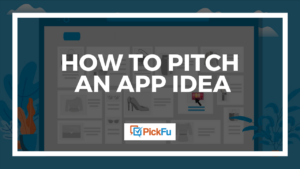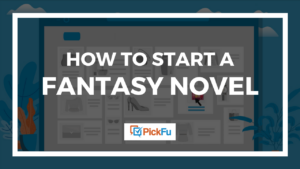Bringing a new product to market is a huge risk.
Every year, millions of entrepreneurs spend time, money, and energy creating products that flop. A 2021 Harvard Business Review study pinpointed why most startups fail.
At the top of the list?
A lack of in-depth market research. In other words, entrepreneurs fail because they don’t prove whether anyone actually wants their product or service.
That’s why proof of concept (POC) testing is something you just can’t skip.
What is proof of concept testing?
Proof of concept testing is when you validate the need for a product before it hits the first stage of development. POC comes after the ideation phase – you’ll already know what you want the service or product idea to look like.
Now you need to see if customers actually need it in the real world. And if so, you need to learn everything you can about who those potential customers are.
You can do proof of concept testing in many different ways (we’ll get into that in a minute). Once you’ve gone through the whole proof of concept process, you can put it all together in a beautiful POC report.
Then you can show that report to stakeholders, potential investors, and other decision-makers. They’ll use the information in the report to decide whether to fund or otherwise support your business idea.
In short, a successful proof of concept test is your biggest asset when you need to prove the viability of your product – even if only to yourself or your team members.
That’s right. Whether you’re funding your own project ideas or getting an investor to back you, POC testing is the #1 ingredient in your recipe for success.
We know it can be so exciting to start a new business. It’s easy to get carried away with product ideation, development, and launching without ever stopping to think of who might actually want your product (or not).
But you risk losing a ton of money, time, and morale if you skip POC testing your new experiments.
How to measure product-market fit with POC testing
Now that we’ve convinced you (we have, right?!) here’s how to test the feasibility of your business or product idea with proof of concept testing.
All it takes are four easy steps. Let’s get started!
1. Figure out who’s in your target audience
The first thing you need to do is find out who’s in your target audience. Who are the end users of your product or service?
When it comes to product development, proof of concept testing comes after the ideation stage. You should already know what your awesome, shiny new product will be.
Take a look at your idea and ask yourself these questions:
- Which age range would benefit from this product the most?
- Which gender identity might like it more?
- Where do they live?
- What do they do for a living?
- How much money do they make?
Let’s say your product is a high-end analog watch that hearkens back to the olden days before Apple Watches were a thing. The watch incorporates natural elements – think twigs, stone, dried flowers, and seashells.
Who would your audience be? Maybe women between the ages of 35 and 50 who live in areas with lots of nature and make at least $80,000 a year (because your analog watches cost $700, and that’s just for a basic model).
Of course, this is nowhere near the price of a $100,000 Cartier or Chopard watch encrusted with diamonds and unicorn hoof powder.
So your end users don’t need to be bajillionaires. Just well-off.
If you want to dig deeper into who your target audience might be, use a tool like Semrush One2Target.
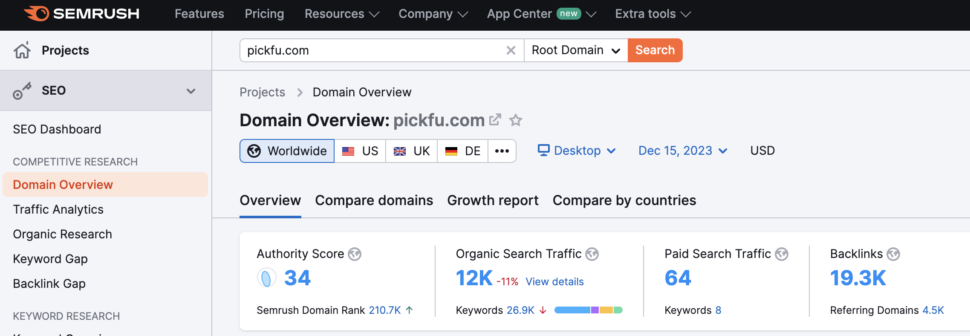
With this tool, you can enter the domains for up to five competitors and see who their target audiences are. This helps you understand where your product fits into the market.
Your actual target audience might be a little different from your estimated audience. It’s hard to know for sure until you start getting customers. But give it your best shot, because you’ll need to have an idea of who your end users are for your next step: trialing your product idea.
2. Validate your product idea
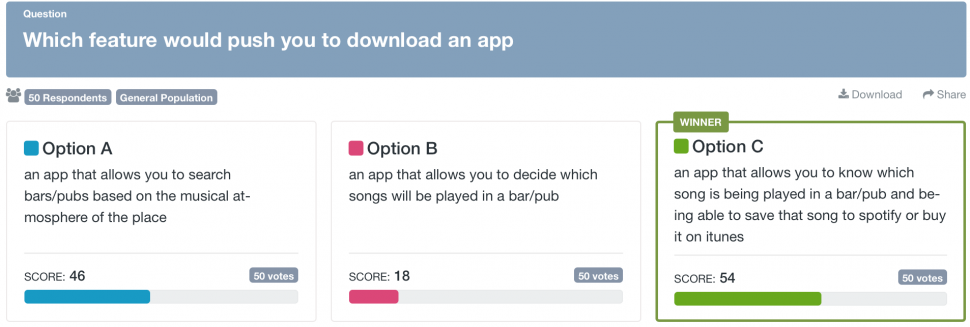
Now it’s time to do some product idea validation.
This step can be nerve-wracking, because you’re about to put your beloved idea in front of your target audience and ask one question: would you use this product or service?
Yikes. They could say no. They could say that they might use it, but only if you made some improvements. They might tell you what those improvements should be.
So take a deep breath and open your mind to the feedback. Remember: this is the step that makes proof of concept testing so valuable. You’re literally about to find out if your concept is proven to be a good one… or not.
And if it isn’t so great, you can always make changes and try again.
PickFu’s market research platform makes it quick and easy to validate your product idea with an Open-Ended poll. All you have to do is:
- Upload a photo, video, or written description of your idea – which is perfect if you’re in an early stage of the product development process
- Ask your audience whether or not they would buy your product or service, and why
- Choose your target audience from PickFu’s giant list of targetable traits
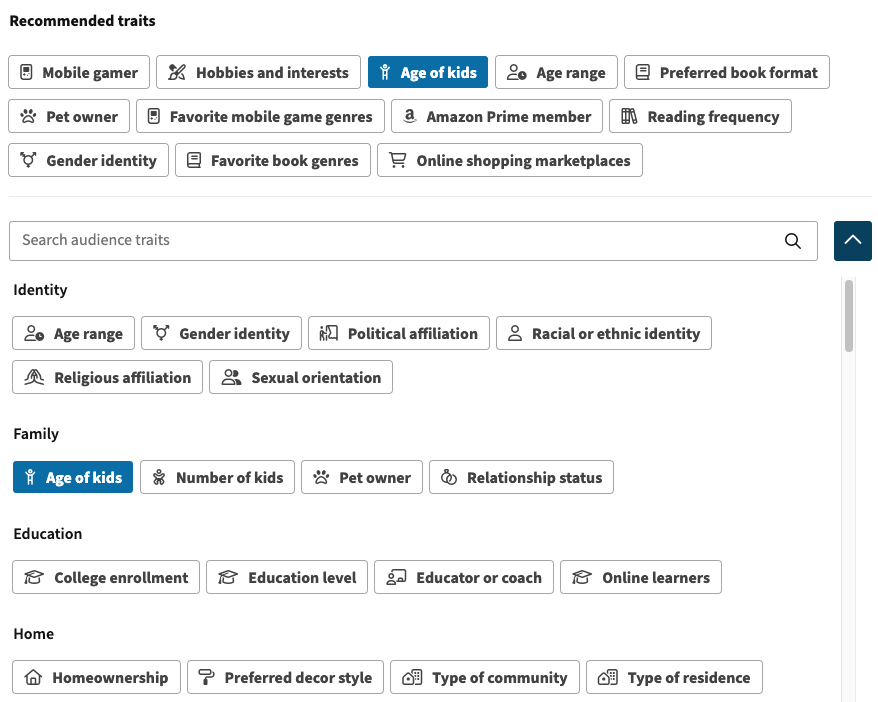
Your poll results will come back within a day (often just a couple hours), and you’ll get valuable feedback. You’ll also get insights on the people who answer your poll, like their age and gender. This can help you narrow down your target audience even further. You can also use the answers to figure out your customers’ pain points.
We decided to run an Open-Ended poll to find out if people would be interested in our nature-inspired analog watch idea. Here’s the question we asked:
“Would you buy an analog watch with natural elements – like dried flowers, wood, and stone – as a gift for yourself or a significant other?”
We added context to help the respondents understand our idea:
“We are trying to find out if there is interest for a product like this. The watches would cost $500-$700 and be beautiful and built to last a lifetime. Instead of looking at a watch that stresses you out, like a FitBit or Apple Watch with a zillion notifications and information on them, our watches would be designed to provide moments of calm reflection.”
Since our idea would be a bit expensive, we created a target audience of people who:
- Make $75-$150k or $150k+ each year
- Are in the 35-44, 45-54, and 55-64 age brackets
We also asked respondents to provide their geographical region so we could gather more insights into our target audience.
The responses were mixed.
Many of our 30 respondents said they would be interested but not for the high price. We loved this response: “I would [be interested in the watch], but I would not pay $500 to $700 for something that looks like potpourri.”
Fair enough. 😆
Others said they’d buy the watch only if it had a lifetime warranty because it sounded fragile. Many expressed a desire to see what the watch would look like, as this would help them decide.
Several liked the idea of a nature-inspired watch designed for calm reflection. Others didn’t see the point or the market for such an expensive watch.
In other words, it’s not a hard no or a hard yes.
We also learned a few things about our target audience:
- Of the nine Northeasterners who responded, only two expressed interest in the watch
- Of our five Midwestern respondents, three expressed interest if the watch cost less and came with a warranty
- Three of our four Pacific respondents said they’d buy the watch
- Zero of our four Rocky Mountains respondents were interested
- Four of four Southeast respondents expressed interest
- One of four Southwest respondents expressed interest
It seems like we might find a stronger target audience in the Southeast, Pacific, and Midwestern regions.
If we were *actually* going to create this product, our next steps would be:
- Lower the price point
- Provide prototypes that our target audience could actually see
- Run another open-ended poll to a target audience of Southeast, Pacific, and Midwestern respondents with the lower price point and prototype
(Of course, this is just a fun example with a small sample size. When POC testing your own product ideas, we’d recommend running multiple polls or against a larger panel to hone in on your target audience).
3. Create and test a minimum viable product

Now, let’s talk about the prototype step of concept testing.
Once you know there’s a market for your product, you can feel good about investing a pinch more time and money into it. Start with a minimum viable product (MVP).
A MVP is a bare-bones, working model of your product idea. It’s often used in software development when developers create a super-basic version of the software they’re developing.
But you can create a basic template or prototype of your product or service even if you’re not developing a new app.
For our pretend analog watch company, we could make a simple watch with one nature-sourced feature. We could then take a video or photo of the watch and run another PickFu poll to do some prototype testing.
This time, we could ask our target audience three things:
- What they like and don’t like about the prototype
- Whether they’d buy it, and why (or why not)
- What additional features they’d like to see on the final product
You can then use this feedback to refine your product to align with what your customer needs.
This is also a good time to gather your development team and test the functionality and usability of your mockup or wireframe. You might even want to recruit a few friends and family members to test out your product. Or, you can host an in-person focus group.
Your goal is to gather feedback on the user experience.
4. Identify success criteria

How will you know if the product is successful?
Now that you’ve validated your product idea, developed a prototype, and refined it according to user feedback, it’s time to show the decision-makers what success looks like.
You’ll want to include things like:
- Project scope: what’s the overall story of your idea, from inception to finished product? What needs to happen to make it succeed? How will it get to market and how long will it take? Tell a story about the lifecycle of the product.
- Goals: what are your goals for the customer, the business, and your product management team? Do they line up with each other? Use all your insights from the POC testing process to show stakeholders the project is worth pursuing.
- Timeline: outline what and when will happen to get your product on the market.
- Budget: how much money will it take to complete each step in the timeline?
- Deliverables: what will the final product or service look like? How will it satisfy your target audience’s pain points?
- Marketing: how will you tell the world about your product? Will you use methods like A/B testing, headline testing, or name testing to make sure your product stands out?
- Product management: how will your team respond to complaints or errors after the product is on the market?
With answers to these questions in hand, you’ll be on your way to wowing the decision-makers with your plan. Best of all?
You’ll have the proof of market demand to back it all up.
Proof of concept testing is only the beginning
The purpose of a proof of concept test is to get you off the ground.
But there’s always something you’ll need user feedback on. In that sense, proof of concept testing never really ends.
So test different aspects of your product frequently. With PickFu, it’s easy. Need to pair your product with a memorable jingle or slogan? Testing slogans is simple with PickFu. So is testing the copy for product listings and advertisements.
You can go beyond the product, too.
Does the brand behind the product or service need a fresh face? Try logo testing and brand name testing with PickFu.
When it comes to proof of concept testing, we’re in your corner. Always. Sign up for free to try PickFu for yourself.
FAQs
What is proof of concept user testing?
Proof of concept testing is a way of validating product ideas before your team starts developing them. To do POC testing, you show your product idea to a group of people in your target audience. Then, you ask them whether they would purchase your product or service. If they say yes, then you have proof of a great concept! If they say no, you’ve got some revising to do.
What are the benefits of proof of concept testing?
Proof of concept testing helps prevent product development disasters. Like spending time, money, and energy on a product or service that no one wants. Look at Google Glass, the Keurig Kold, and Horizon Worlds for prime examples of this.
What is the difference between a POC and a prototype?
A proof of concept (POC) is a test that demonstrates whether a product idea is viable. In other words, that there are enough customers who want or need the product. A prototype is an early version of a product. You don’t need to have a prototype to start early POC testing. All you need is an idea and a way to describe it to your target audience.


